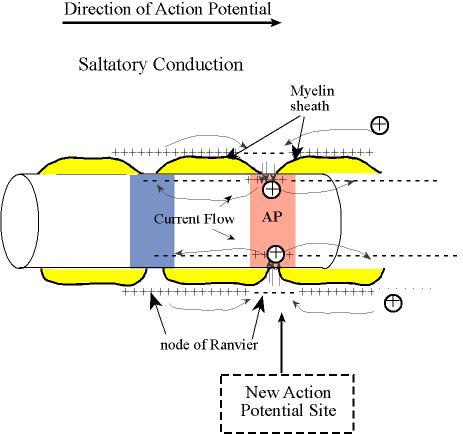Nerve physiology
Axonal Polyneuropathy changes in EMGEMG/NCV section Learn about the Brain Learn about nerves Nerve Fibers conduction described in detail below.
Nerve Cell Physiology-3
please return to page-1 of nerve physiology page-2
Between areas of myelin are non-myelinated areas called the nodes of
Ranvier. Because fat (myelin) acts as an insulator, membrane coated
with myelin will not conduct an impulse. So, in a myelinated neuron,
action potentials only occur along the nodes and, therefore,
impulses 'jump' over the areas of myelin - going from node to node
in a process called saltatory conduction (with the word saltatory
meaning 'jumping'):
Because the impulse 'jumps' over areas of myelin, an impulse travels much
faster along a myelinated neuron than along a non-myelinated neuron.


Multipolar
neuron

Unipolar
neuron
Bipolar neuron
Multipolar neurons are so-named because they have many (multi-) processes that extend from the cell body: lots of dendrites plus a single axon. Functionally, these neurons are either motor (conducting impulses that will cause activity such as the contraction of muscles) or association (conducting impulses and permitting 'communication' between neurons within the central nervous system).
Unipolar neurons have but one process from the cell body. However, that single, very short, process splits into longer processes (a dendrite plus an axon). Unipolar neurons are sensory neurons - conducting impulses into the central nervous system.
Bipolar neurons have two processes - one axon & one dendrite. These neurons are also sensory. For example, biopolar neurons can be found in the retina of the eye.
continue to next page of nerve Synapses
-
- CIDP DIAGNOSIS
- Treatment CIDP
- M.M.F.
- Metal toxicity and learning
- Vitamin-C
- A normal EMG/NCV in CIDP
- Lymes
- Axonal EMG
- Painful neuropathy
- Muscle Histology
Autoimmune cause
Key words : action, potential, nerve, membrane, depolarizes, negative, electron;
